
About UsThe Numismatic Bibliomania Society is a non-profit organization promoting numismatic literature. For more information please see our web site at coinbooks.org SubscriptionsThose wishing to become new E-Sylum subscribers (or wishing to Unsubscribe) can go to the following web page link MembershipThere is a membership application available on the web site Membership Application To join, print the application and return it with your check to the address printed on the application. Membership is only $15 to addresses in the U.S., $20 for First Class mail, and $25 elsewhere. For those without web access, write to: David M. Sundman, Secretary/TreasurerNumismatic Bibliomania
Society AsylumFor Asylum mailing address changes and other membership questions, contact David at this email address: dsundman@LittletonCoin.com SubmissionsTo submit items for publication in The E-Sylum, just Reply to this message, or write to the Editor at this address: whomren@coinlibrary.com
BUY THE BOOK BEFORE THE COINYou won't regret it! |
- WAYNE'S WORDS: THE E-SYLUM JUNE 14, 2009
- STOCKLEY NUMISMATIC LITERATURE INVENTORY SALE
- NEW BOOK: WORLD ENCYCLOPEDIA OF MEDALS AND MEDAL COLLECTING
- BOOK REVIEW: A POCKETFUL OF HISTORY BY JIM NOLES
- UPDATE: GOBRECHT JOURNAL COLLECTIVE VOLUME #5
- ANS MAGAZINE SPRING 2009
- MORE ON DYE'S COIN ENCYCLOPEDIA
- MORE ON CUTTING UP NUMISMATIC LITERATURE
- FOLLOW UP: WOMEN'S ROYAL AIR FORCE "DOG TAG" COIN
- QUERY: VINCENT ADERENTE'S MURALS AT THE DENVER MINT
- QUERY: WASHINGTON, D.C. AREA BOOKBINDER SOUGHT
- MORE INPUT FOR ANS LIBRARY DIGITIZATION PROJECT
- FORMER ANA EXECUTIVE INVESTIGATED; ELECTION BALLOTS DUE JUNE 26
- DICK JOHNSON ON THE U.S. MINT STRATEGIC COIN RESERVE STOCKPILE
- RESIDENTS LINE UP FOR GUAM QUARTERS
- ANOTHER COIN-BASED TAX EVASION SCHEME
- QUERY: THE SILVER DECA COIN OF ATLANTIS II
- IMAGES OF JAMAICA'S NEW $5000 BANKNOTE
- ROYAL MINT ISSUES 2009 KEW GARDENS 50 PENCE COIN
- MANY NUMISMATIC HOBBY LEADERS BECAME INTERESTED AS TEENAGERS
- FATHER OF KILLED SERVICEMAN GIVES SON'S CHALLENGE COINS TO OFFICIALS
- CHINESE CONSTRUCTION WORKERS UNEARTH TWO TONS OF COINS
- THE WORLD'S FIRST COIN-OPERATED VENDING MACHINE
- DROP A BANKNOTE, GET FINED FOR LITTERING
- FEATURED WEB SITE: POLISH NUMISMATIC SOCIETY
WAYNE'S WORDS: THE E-SYLUM JUNE 14, 2009
 Among our recent subscribers are Carrie Whipple and Jay Guberman. We now have 1,231 subscribers.
Among our recent subscribers are Carrie Whipple and Jay Guberman. We now have 1,231 subscribers. Pete Smith writes:
This week we had two numismatic literature sales close (Kolbe and Sklow). First up, dealer Richard Stockley announces a sale of fixed price material. Next, a next book on medals is in the works, and I provide a short review of Jim Noles' A Pocketful of History.
Other topics include bookbinders, digitizing institutional numismatic libraries, and new issues from the Royal Mint and the Bank of Jamaica. In topics continued from previous weeks we discuss Dye's Coin Encyclopedia and cutting up numismatic literature.
To learn about the world's first coin-operated vending machine, and which numismatic book the author of Forrest Gump recommends, read on. Have a great week, everyone!
Wayne Homren
Numismatic Bibliomania Society
STOCKLEY NUMISMATIC LITERATURE INVENTORY SALE
Numismatic literature dealer Richard Stockley writes:Richard Stockley
222 Ste. Anne
Ste. Anne de Bellevue, QC
Canada H9X 1N7
rstockley@videotron.ca
514-366-1704
www.abebooks.com/bookseller/stockleysbooks
NEW BOOK: WORLD ENCYCLOPEDIA OF MEDALS AND MEDAL COLLECTING
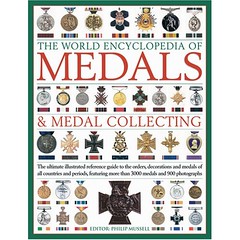 Medals come in all shapes, sizes and metals, and this superb guide to the world of medals, orders and decorations considers every aspect of this important branch of numismatics. Fully illustrated in colour throughout with over 900 photographs.
Medals come in all shapes, sizes and metals, and this superb guide to the world of medals, orders and decorations considers every aspect of this important branch of numismatics. Fully illustrated in colour throughout with over 900 photographs. Hardcover: 256 pages
Publisher: Lorenz Books (June 25, 2009)
To preorder the book, see: World Encyclopedia of Medals and Medal Collecting: The Ultimate Illustrated Guide to Collecting and Evaluating Medals (http://www.amazon.com/gp/product/0754819035
/ref=pe_5050_12263870_snp_dp)
BOOK REVIEW: A POCKETFUL OF HISTORY BY JIM NOLES
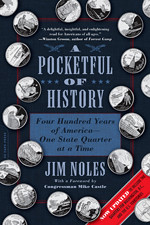 A Pocketful of History by Jim Noles is subtitled Four Hundred Years of America - One State Quarter at a Time. Published by Decapo Press, the new 362 page paperback retails for $16.00
A Pocketful of History by Jim Noles is subtitled Four Hundred Years of America - One State Quarter at a Time. Published by Decapo Press, the new 362 page paperback retails for $16.00From the publisher's site:
Author Noles is not a coin collector, but his curiosity about the 50 States Quarter series led to this book.
Noles has researched the stories behind each of the quarter designs. I'll admit to being a bit snowblinded by the series - there were new designs coming out every few weeks for a decade, and many of them I hadn't really given a second thought to.
But a book like this is well worth reading to gain that background - often there's more to the story than one might think. For example, I learned a lot reading about the wild horses of Nevada, and the creation of Mt. Rushmore in South Dakota.
Numismatists should be warned that it's a non-traditional numismatic book - there's nary a word about mintages, proof or uncirculated strikes, silver planchets, mint errors, etc., and David Ganz' role in promoting the concept is given only a passing mention.
Nevertheless, the book has found a place on my shelf. Besides, what other numismatic book has a plug from Winston Groom, author of Forrest Gump?
For more information, see: www.perseusbooksgroup.com/dacapo/book_detail.jsp?isbn=0306817896
UPDATE: GOBRECHT JOURNAL COLLECTIVE VOLUME #5
Last week I published information about the new Gobrecht Journal Collective Volume Number Five from the Liberty Seated Collectors Club. LSCC Secretary-Treasurer Len Augsburger adds: The prepublication ordering for the Gobrecht Journal Collective Volume #5 closed June 1st. Orders will continue to be accepted by John McCloskey at the regular price of $60 per copy, however, these orders will not be fulfilled until September as the first printing of 200 copies is sold out. We are very pleased with the response to the prepublication notice. Send orders to:
The prepublication ordering for the Gobrecht Journal Collective Volume #5 closed June 1st. Orders will continue to be accepted by John McCloskey at the regular price of $60 per copy, however, these orders will not be fulfilled until September as the first printing of 200 copies is sold out. We are very pleased with the response to the prepublication notice. Send orders to: John McCloskey
President, LSCC
5718 King Arthur Drive
Kettering, OH 45429
ANS MAGAZINE SPRING 2009
The Spring 2009 issue of the American Numismatic Society's ANS magazine has a number of interesting feature articles:- The Fairest of Mortal Cities: The History and Coinage of Akragas by Andrew Meadows
- "Purely Social and Quite Informal" - The Centennial of the New York Numismatic Club, by John M. Kleeberg
- Land and Sky: The Medallic Work of Ron Dutton by Donald Scarinci
- The Charles Anderson Dana Medal by Augustus Saint-Gaudens (1899) by Robert Hoge
The issue also features a number of society-related articles, including
- Library News by Elizabeth Hahn
- Current Cabinet Activities by Robert Hoge
- Obituary of Dr. Julius Korein
- From the Collections manager: Recent Acquisitions by Elena Stolyarik
- Book Reviews
- Recent News
The issue is well illustrated and nicely laid out, as always. Kleeberg's article is a great history of numismatics in New York, touching on not only the ANS and the New York Numismatic Club, but the American Numismatic Association as well. Below is an photo taken at the inaugural meeting of the NYNC at Keen's Chop House.
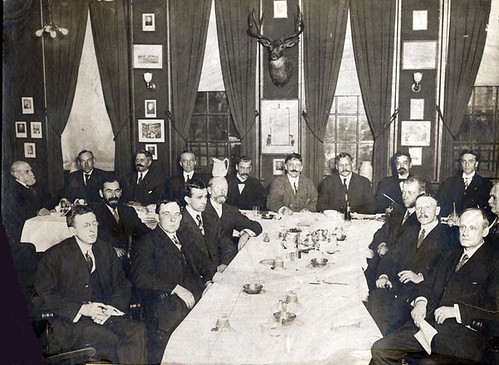
Bob Hoge's extensive article on the Charles Anderson Dana medal was inspired by a recent eBay purchase for the society.

Bibliophiles will especially enjoy the book reviews (on George Selgin's Good Money and Medieval Slavic Coinages in the Balkans by Dimnik and Dobrinic) and Elizabeth Hahn's Library news. Kudos to the following individuals for their recent book donations:
- Mr. William A. Burd
- Mr. Frank L. Kovack
- Mr. Anthony Terranova
Her article includes a list of all ANS Librarians from 1858 to date.
QUICK QUIZ: without peeking at the article, who can tell us who was the first librarian of the American Numismatic Society?
THE BOOK BAZARRE
MORE ON DYE'S COIN ENCYCLOPEDIA
A large compendium of numismatic knowledge with hundreds of illustrations throughout, Dye's work was only half finished when he died. Unknown to most today, the work was completed by Ebenezer Locke Mason and Edward Maris, which certainly increases the volume's importance. Oddly, Dr. Maris doesn't seem to have written the section on the New Jersey coppers, despite the publication of his magnum opus two years before. Dye is more numismatically well-known today for being the publisher of a number of counterfeit detectors. Davis 334."
I doubt much of the information was new at the time. As you point out, Crosby had been published by this time. That said, it's a good book (with terrible illustrations) and probably accurately reflected the state of the art in numismatic knowledge reasonably well.
MORE ON CUTTING UP NUMISMATIC LITERATURE
During my senior year (1970), I had completed most of my course requirements, but wasn't allowed to go home during the day, so I spent a few hours each day in the school library. The library had a huge, battered and ancient edition of Webster's International Dictionary, probably from the early 1900's. Flipping through it casually one day, I spotted an entry for a coin denomination. I don't recall which one -- franc, mark, shilling, escudo, peseta -- but as I flipped through more pages, I found more coin denominations. I hit upon the idea to compile a dictionary of coin denominations, and began a card file.
I went through the denomination indexes in Yeoman's Modern World Coins and Current Coins of the World, and Craig's Coins of the World. Then I started going through every other coin book I could lay my hands on. I was especially interested in the origins of the words, and how there are groups of related denominations -- that is, words with similar origins.
For example, several countries use denominations based on the words "crown" or "lion" or "shilling" or on the name of a king or saint. By 1974 I had recorded over 1,200 denominations and was working hard on tracking down the origins of the words. --- Then, I discovered Frey's Dictionary of Numismatic Names, which was reprinted in 1974. Frey had done the same work more than 50 years earlier!
I was disgusted that I had wasted so much time, and set the file cards aside for more than 25 years. Then I found a book by Adrian Room about coin names. Room has authored many books, several of them on word origins. His book on coin names was rather slim --- a few hundred listings -- but it made me realize that Frey wasn't particularly interested in the origins of the terms, and that many new denominations have come along since 1917 when Frey's work was originally published. So, I am tinkering again on this coin name project, mainly focusing on terms which have come into use during the past 50 years.
One thing I discovered in this research is that most of the denominations listed by Frey are not true denominations, but are merely popular names applied to certain coins. I began to think about how to determine the official denomination of a coin, and that is when I noticed that, prior to the 1700's, most coins did not carry a denomination.
Some had a numeral or even an initial for the denomination, but seldom was the actual denomination clear. In earlier times, most states tended to issue one or two gold coins, one or two silver coins and maybe, as an afterthought, some copper coins. Generally copper coins were an afterthought in ancient times, and again after the middle ages.
Money in earlier times meant silver and gold and was mostly for the use of the upper classes and merchants. That relatively small group of people knew what coins were in circulation, and didn't need a stated denomination. Coin names spelled out in full or in part become common only on the copper coins, made for the use of the lower classes. I now have a new hobby -- collecting coins which contain the denomination fully spelled out -- coins which name themselves. I must also confess to cutting up many books and auction catalogs. In the 1970's, to build my own library, I began buying small numismatic libraries and bidding on odd lots of numismatic books and auction catalogs. By 1980 I had one entire room just for piles of duplicate numismatic material -- periodicals, books and auction catalogs -- thousands of them.
In 1981 I began work on my first magazine, East Asia Journal, by going through those piles, mainly the auction catalogs, and cutting out illustrations of East Asian coins and paper money. I was creating a photo file to use for illustrating articles in the magazine. When I had finished, I still had piles and piles of cut-up auction catalogs.
Thinking that Numismatics International might be able to use these to illustrate its magazine, I mailed several large boxes of the stuff to the editor. Later I began keeping a card file on rare Chinese coins and their appearances in auctions. I now try to obtain three copies of important sales of Asian coins and paper money, from the 1950's onward -- one to keep, and two to cut up (left page and right page) for my files.
I am now trying to track individual rare coins using auction photos. I imagine there are other collectors who cut up auction catalogs for similar purposes. At first it broke my heart to cut up books, but when you see them by the thousands -- and at that time, world auction catalogs and world coin books were not widely collected nor worth much -- you begin to see that they can be expendable.
Unfortunately, numismatic books and auction catalogs are becoming too expensive to cut up -- that is to say, their original cost is too high. The good news is that scanning technology may make this unnecessary in the future.
FOLLOW UP: WOMEN'S ROYAL AIR FORCE "DOG TAG" COIN
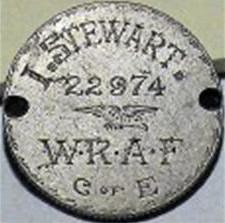
David wrote:
Such pieces are quite common around the WW1 period, and the style of this one is typical. The first approach is usually to write to the regimental headquarters/museum, or equivalent for other services; they are usually very helpful, but do expect to get asked for a donation {£10-£15ish}. I have done it myself once, for a specimen I own; the amount of information they have available is variable, but I was quite lucky.
I don't know how much genealogical knowledge you have to start with, so please forgive me if I have just been telling you what you know already.
Marlene wrote:
You are right in assuming that I know nothing about Genealogy, but I was able to find out that Isabella Stewart signed up with the WRAF on October the 29th, 1918 at the age of 19. When Isabella signed up she was living at 15 Powis Place in Aberdeen. Next of kin was written down as Mrs. Stewart same address, mother, but no first name on the mother. This would bring her date of birth to around 1899.
It was a good thought that maybe I could reunite the coin with the family but I guess that will never happen. Thanks for the information, I greatly appreciate it.
David wrote:
Could Isabella have been the girlfriend or fiancée of somebody in your family of about the same age as herself? Put another way, do you know whether your father got it as a random acquisition or because it had meaning to someone who handed it down to him? Your grandfather being perhaps the most obvious candidate, by virtue of his probably being about the right age.
Another possibility: It also occasionally happened that comrades at arms asked each other to take certain of their more valued and sentimental belongings back to their loved ones if they died in action, and Isabella's tag might just have fallen into that category.
Glad to have been of help, but I fear that the chances of finding the family are small. Having said which, you never know quite what a bit of Googling around might produce…
To read the earlier E-Sylum article, see: WOMEN'S ROYAL AIR FORCE "DOG TAG" COIN FOUND (www.coinbooks.org/esylum_v12n22a22.html)
QUERY: VINCENT ADERENTE'S MURALS AT THE DENVER MINT
The photographs will then be posted on the Smithsonian American Art Museum's online database of American painters, she said.
“I want everyone to know the work he did,” King said.

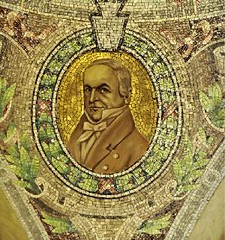
An artist herself, King said she was pleased to recently learn that Luzerne County officials plan to refurbish the century-old building, work that will include cleaning the marble and artwork restoration.
“They would be so pleased to see their contributions are still appreciated,” she said of her ancestors.
King is writing a book about her Italian-born grandfather, who forged a successful career painting murals in churches, banks, libraries, hotel ballrooms and many government buildings until his death in 1941.
Several of his most famous murals are in the U.S. Mint in Denver, the ceiling of the Boston Opera in Massachusetts and the Detroit Public Library in Michigan, she said.
To read the complete article, see: Granddaughter to photograph courthouse art for Smithsonian (www.timesleader.com/news/
A_true_labor_of_love_06-08-2009.html)
QUERY: WASHINGTON, D.C. AREA BOOKBINDER SOUGHT
I need to take a small quantity of them to a bookbinder. The catalog has card covers and I always have ten copies hardbound to give to the ten people who most contributed to the catalog and my usual bookbinder is no longer in business.
I also have a few extra hardbound for those who want to purchase them for their libraries. Does anyone know of a bookbinder in Northern Virginia or somewhere near the Washington, DC area who can and will do short runs of catalogs? If so, please contact me at HADaniel3@msn.com.
To visit the Long's Roullet Bookbinders web site, see: http://longs-roullet.com/
MORE INPUT FOR ANS LIBRARY DIGITIZATION PROJECT
Last week Andy Meadows of the American Numismatic Society wrote:Andy asked for input from E-Sylum readers on how to prioritize the digitization effort. Jonathan Brecher writes:
Jonathan provided this link to the Google Books site:
For more information about Google's Special Collections program, see: How can I get my library involved? (books.google.com/support/bin/answer.py?hl=en&answer=43741)
Jonathan adds:
What's the general feel about the coverage of the ANS and ANA libraries (aside from a platitude that each has some of the same things and some items that the other is lacking)?
THE BOOK BAZARRE
FORMER ANA EXECUTIVE INVESTIGATED; ELECTION BALLOTS DUE JUNE 26
The DA's office began reviewing information it received on Cipoletti about eight weeks ago to decide whether to open a criminal investigation, District Attorney Dan May said.
Cipoletti said Friday he was unaware of the investigation.
In 2007, the Economic Crimes Division examined about 3,600 such inquiries, of which 277 were investigated, May said. Of those, criminal charges were filed on 253.
The DA's action comes after four years of legal proceedings involving Cipoletti and the ANA, a federally chartered association for coin collectors headquartered in Colorado Springs.
The recent addendum accuses Cipoletti of civil theft. The new documents filed May 19 in 4th Judicial District Court claim that while Cipoletti was employed by the ANA, he intentionally took, misappropriated or converted monies belonging to the ANA, used ANA resources for personal benefit, double-billed travel expenses, personally accepted money that was to be paid to the ANA for services, billed private clients using ANA time and resources, and misrepresented the status of his vacation and sick time.
Cipoletti refuted the claims Friday.
The ANA's allegations stem from findings that surfaced during an arbitration regarding Cipoletti's employment contract, said Larry Shepherd, who took over as the ANA's executive director in March 2008.
"There were certain things that we knew and certain things that came to light as we did our investigation, and we feel we have an obligation to our membership to disclose those," he said this week.
To read the complete article, see: Ex-numismatic association director under investigation (www.gazette.com/news/cipoletti-55903-filed-arbitration.html)
I won't publish Tom's specific endorsements here, but I have to agree with his sentiments. The previous election was an overwhelming referendum against the previous Executive Director and the Board that supported him. Great progress has been made, but it's important to elect a slate of officers that will continue the cleansing and restoration process.
The E-Sylum readership is made up of great folks who are serious about their hobby, and a number of E-Sylum regulars on the ballot starting with Cliff Mishler. Others who contribute regularly include Joe Boling, Wendell Wolka and Mike Ellis. Some candidates are newcomers to hobby politics, but may well bring a fresh perspective. I'm sure the ANA members among you will carefully consider your votes.
DICK JOHNSON ON THE U.S. MINT STRATEGIC COIN RESERVE STOCKPILE
The Federal Reserve reports they have sufficient coin on hand to meet anticipated demand. That's bad for the U.S. Mints. With coin orders dried up from the Fed, they have nothing to strike for circulation. We know they are overactive in striking coins for collectors, if you include presidential dollars, spouse coins and the next ersatz series of collector interest -- the National Parks Series.
However, the economy is forcing citizens to search out all the odd coins around the house and turn them in. Coinstar (the coin counting vending machine company) has processed 42.3% more coins this year over last. With all those coins flowing back to the Fed banks, they have, in effect, become our nation's strategic coin reserve stockpile. And they have the vaults to store them.
What the Treasury wants to do is strike coins in anticipation of some disaster, to keep the Mints busy and their workers employed. Trouble is they would have to find a secure place to store all those coins. How many empty vaults would they need?
Bad idea!
Project that scenario into the future, at least for the lower denomination coins, which now cost nearly face value to manufacture. The costs of metal will undoubtedly rise in the future. By some future time when the coins might be issued they couldn't be! These coins would be immediately melted for their metal content, worth more than face value, if they did.
I can see the need of America stockpiling strategic materials, from gasoline to plutonium. But not coins.
In private industry, the most efficient and profitable manufacturers are those who have achieved "inventory on demand." Their production lines are geared to received the parts the day they are needed to make the goods in process that day. No need for inventory, no need for storage. With computers and on time delivery (from suppliers) this is easy to accomplish. That should be the goal of the U.S. Mints.
Stockpiling coins which will inevitably never be able to be placed in circulation is just a dumb idea.
A newspaper columnist, Glenn Ickler, in Massachusetts who had read of this proposal in Coin World responded in an article this week. It's ell worth reading: Ickler: Time to pinch pennies (http://www.dailynewstribune.com/opinion/
x1246963770/Ickler-Time-to-pinch-pennies)
RESIDENTS LINE UP FOR GUAM QUARTERS
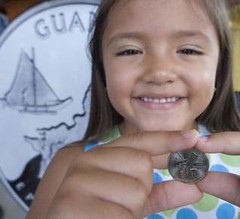 The image of Guam has been pressed into the hard metal of 90 million quarters, which have already begun circulating throughout the country. The commemorative coin was released on Guam yesterday.
The image of Guam has been pressed into the hard metal of 90 million quarters, which have already begun circulating throughout the country. The commemorative coin was released on Guam yesterday."Coins are more than just a means of commerce, they also provide education," said United States Mint Director Ed Moy, who was at Skinner Plaza in Hagåtña for the celebration of the release.
A person carrying change might be curious about the boat pictured next to the outline of the island, Moy said. They might want to learn about the flying proa, or about the latte stone, or about the Chamorro phrase "Guahan I Tano' ManChamorro" printed on the coin. In doing so, they'll understand a little more about Guam, Moy said.
"I think it looks good," said 12-year-old Corey Santos of Agana Heights, who was waiting to receive one of the free Guam quarters handed out by Gov. Felix Camacho, first lady Joanne Camacho and Moy.
Judith Gagan of Yona was in line yesterday with her children and her co-worker's children, to exchange bills for $10 rolls of Guam quarters, which she will send to family in the mainland.
"It's exciting," Gagan said. "Guam has a quarter for its culture."
At the ceremony, the governor thanked the community for 11,922 votes on the quarter design. Camacho said the quarter will help share Guam's history, culture and language with the world.
To read the complete article, see: Residents line up for Guam quarters (www.guampdn.com/article/20090605/NEWS01/906050314/1002)
ANOTHER COIN-BASED TAX EVASION SCHEME
Not surprisingly, the IRS took Cordner to court for underpayment of taxes. Key to Cordner's subterfuge was his insistence that, as long as Double Eagles remain legal tender, then they are “money” for the purposes of calculating gains and losses under the tax code. The judge would have none of this: “regardless of whether technically the Double Eagle gold coins might be legal tender they are not circulating tender, or ‘money,' within the meaning of [the law]…rather, these gold coins are ‘property (other than money)' to be valued at their fair market value”.
[The citation is: California Federal Life Insurance Company v. Commissioner of Internal Revenue, 76 T.C. 107 (1981)]
The moral: Kahre should have done a little research on Lexis-Nexis before he tried the same trick!
To read the earlier E-Sylum article, see: LAS VEGAS BUSINESSMAN FACING JAIL FOR GOLD COIN TAX SCHEME (www.coinbooks.org/esylum_v12n23a22.html)
QUERY: THE SILVER DECA COIN OF ATLANTIS II
Is anyone familiar with these? I contacted Oded Paz of the Unrecognized States Numismatic Society, and he may be able to provide an illustration for a subsequent issue. -Editor
The schemers had their own silver coin, dubbed the “deca”; they got some press in Esquire; and they had their own homemade boat. But the ship sank in a hurricane, attention from the Haitian government forced the project into quiet mode (canceling the highly entertaining newsletter Atlantis News), and no new libertarian Atlantis ever arose in the Caribbean.
The king of the “take over existing land” plan was Mike Oliver, a Nevada-based real estate developer and coin dealer who had published a book called A New Constitution for a New Country in 1968.
To read the complete article, see: 20,000 Nations Above the Sea (www.reason.com/news/show/133865.html)
Visit the web site of The Unrecognized States Numismatic Society (www.usns.info)
IMAGES OF JAMAICA'S NEW $5000 BANKNOTE
A few issues back we had an article about the new Jamaican $5,000 banknote, but we didn't have any images of the note. Well, an E-Sylum reader noted that an article in the June 22 issue of COIN World pictures the note. The images were provided by the Bank of Jamaica. The note, worth about 57 USD, goes into circulation in September.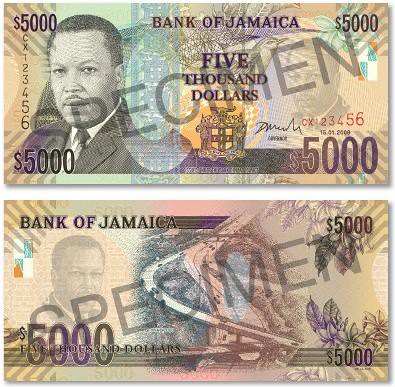
To read the earlier E-Sylum article, see: JAMAICA TO ISSUE NEW $5,000 BANKNOTE (www.coinbooks.org/esylum_v12n21a21.html)
ROYAL MINT ISSUES 2009 KEW GARDENS 50 PENCE COIN
The first few years of Kew Gardens saw growth, but not the scientific stature it would eventually attain. The beginning of real change occurred in 1771 when King George III met Joseph Banks, an entrepreneur who had just returned from a world voyage with James Cook aboard the Endeavour. Banks had accumulated an impressive collection of animals, plants and portfolios.
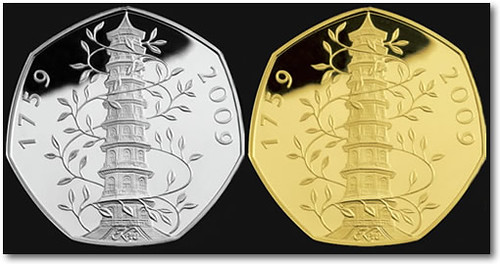
Issued as legal tender, the Royal Mint has created the heptagon (seven-sided) coin with Ian Rank-Broadley's portrait of Queen Elizabeth on the obverse, or "heads side." Inscribed are "Queen Elizabeth II," "DG REG FD" and "Fifty Pence."
Christopher Le Brun designed the reverse to include the Pagoda and plants. He describes his choice:
To read the complete article, see: 2009 UK Kew Gardens Coins (www.coinnews.net/2009/06/11/2009-uk-kew-gardens-coins/)
MANY NUMISMATIC HOBBY LEADERS BECAME INTERESTED AS TEENAGERS
Similarly, John J. Ford Jr. and Arthur M. Kagin, both recently deceased, were highly important in the rare coin trade in their time, and each began while in his teens.
Dwight Manley, barely a teenager, decided to become a professional numismatist after attending my "All About Coins" class at the American Numismatic Association Summer Seminar, as did teenaged Kerry Wetterstrom - both of whom have gone on to make indelible imprints on the hobby.
There seems to be something infectious about coin collecting if the thrill is captured during the formative years of youth. I suggest it is quite likely that starting as a teenager is the rule, not the exception, on the high road to success. Harvey Stack, dean of American professional numismatists now that Art Kagin has passed away (Art started in 1933, and joined the family business in 1940), joined the family business at a very young age.
Henry Chapman and S.H. Chapman, the most prominent rare coin dealers at the turn of the 20th century, began while teenagers.
With all this in mind, perhaps the Professional Numismatists Guild should roll out a "teenage dealer education program." Of course, to paraphrase a Chinese proverb, the best time to have started in numismatics was when you were a teenager, and the second best time is now!
To read the complete article, see: Veteran numismatists trace roots to childhood (www.coinworld.com/articles/2009_06/veteran_numismatists.aspx)
FATHER OF KILLED SERVICEMAN GIVES SON'S CHALLENGE COINS TO OFFICIALS
"I was overwhelmed by everything they have done, just overwhelmed. It was amazing," Trahan said, speaking earlier this week from Virginia, where the family was attending a Navy awards ceremony for their son.
Navy Petty Officer 2nd Class Tyler J. Trahan, an explosives technician working with a Navy Seals team, was killed in action on April 30 in Iraq. He was two days' shy of his 23rd birthday.
His funeral was attended by 500 people, including state and local officials, and well over 1,000 residents carrying flags lined the streets to show their respect.
"It was a very nice gesture on the part of the Trahan family," Selectman Jean C. Fox said of their decision to give the challenge coins as a show of gratitude. "They have maintained incredible courage and dignity throughout this whole process."
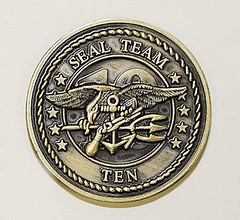
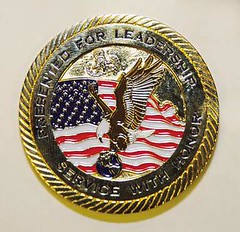
Challenge coins are believed to have their origin during World War I when a U.S. Air Force, then Army Air Service, lieutenant had the gold-covered, bronze coins made for his squadron. According to www.coinforce.com, one of the pilots placed the coin in a pouch around his neck and was eventually shot down by the Germans. While in transport to a POW camp, the pilot escaped and made contact with a French patrol who believed him to be the enemy until he showed his coin as proof of American citizenship. From then on, so the story goes, his squadron always carried the coins with them.
Every branch of the military has continued the tradition of carrying coins with various insignias to represent unity and individual accomplishment. Recipients are challenged to produce the coin when another member of the group shows his or her coin. Anyone who does not produce a coin has to do something — most commonly buy a round of drinks — for the others.
Jean Pierre Trahan said that he distributed 25 coins to those who have helped his family during such a difficult time.
To read the complete article, see: Father of serviceman killed in Iraq gives son's challenge coins to officials as sign of gratitude (www.southcoasttoday.com/apps/pbcs.dll/article?
AID=/20090525/NEWS/905250348)
CHINESE CONSTRUCTION WORKERS UNEARTH TWO TONS OF COINS
Zhao Aiguo, director of the cultural relics protection and tourism bureau in Liquan County, Shaanxi, told Xinhua Wednesday that the coins were found when workers were excavating the grounds Tuesday for construction of another building.
They reported their discovery to the bureau and soon more than 70 archaeologists, officials and police were sent to the site.
It took more than five hours to dig the ancient coins out of a vault made of grey bricks.
Zhao said they were in circulation for more than 750 years during the Tang, Song (960-1279) and Yuan (1279-1368) Dynasties.
The vault measures 1.5 meters in width and length and one meter in height. It is believed to have been built during the Yuan Dynasty.
The coins have been sent to a local museum and archaeologists were counting them. Because there were so many, it might take a week to know the exact number and categories, Zhao said.
The site of the discovery was part of a temple built by an ancient emperor in memory of his mother between 180 BC and 157 BC. Zhao cited archaeologists as saying that the coins might be donations from believers who visited the temple.
To read the complete article, see: Two tonnes of ancient coins found in history-laden Chinese province (http://news.xinhuanet.com/english/2009-06/10/content_11520297.htm)
THE WORLD'S FIRST COIN-OPERATED VENDING MACHINE
It's not exactly numismatic, but the above mention of temple donations reminded me that I wanted to write about something interesting my father-in-law was watching on TV a week or so ago. It was a History Channel episode on various mechanical gizmos designed for ancient temples to capture attention and generate awe in the temple-going public. The greatest designer of these contraptions was Heron, a Greek mathematician and engineer. The show, titled "Ancient Discoveries" originally aired in 2007 and features recreations of many of Heron's devices.One was a mechanism to automatically open the temple doors. No big deal today, where every supermarket and office building has automatic doors. But huge ceremonial doors weighing tons? The temple priests would address the congregation on the steps of the temple and light a sacrificial fire. The heat of the fire created a vacuum in a hidden chamber below, and the mechanism caused the temple doors to open themselves. To the assembled crowd it was magic or the Hand of God.
Other altar sculptures would dance or sing, all powered by simple principles of water, gravity, heat or vacuum. It was amazing to see what clever people could build without the benefit of today's technology. McGivver would be right at home.
Anyway, one of the simplest devices turned out to be worth a fortune to the temple priests. Heron devised what was essentially a primitive coin-operated vending machine.
From Wikipedia:
To read the Wikipedia article, see: Vending machine (http://en.wikipedia.org/wiki/Vending_machine)
DROP A BANKNOTE, GET FINED FOR LITTERING
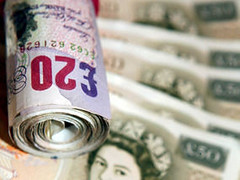 A SHOPPER who dropped a £10 note in the street by accident has been fined – for littering.
A SHOPPER who dropped a £10 note in the street by accident has been fined – for littering. Arthritis sufferer Stewart Smith was leaving a charity shop when the banknote fell from his hand, without him realising.
Stewart, 36, at first expressed his gratitude to the two officers who approached him to point out that the note had fallen to the ground.
But moments later, after recovering the note, he was stunned to be accused of littering and slapped with a £50 fixed-penalty notice.
It is thought the police were implementing a zero-tolerance approach to littering as part of a concerted effort to clean up their local area in Ayr.
But law and order campaigners last night slammed the move, describing it as petty and a waste of police resources.
Matthew Elliott, Chief Executive at the TaxPayers' Alliance, said the action was a waste of police time and resources.
He said: “It's bizarre that the police officers saw fit to fine a man for dropping money. It was clearly a mistake and they should show understanding.”
Conservative MP Philip Davies said: “This seems on the face of it to be a very petty action. This sounds like a case where common sense has been ignored.”
Strathclyde Police last night insisted Mr Smith had dropped several papers and ignored a warning to pick them up.
To read the complete article, see: FINED £50... FOR DROPPING A TENNER (http://www.express.co.uk/posts/view/106719/Excuse-me-you-ve-dropped-a-tenner-that-ll-be-a-50-fine)
FEATURED WEB SITE: POLISH NUMISMATIC SOCIETY
This week's Featured Web Site is the Polish Numismatic Society.During the prewar years Polish numismatists were associated in turns in: Polish Archeological Society, then in Polish Archeological and Numismatic Society and since 1991 in the present organization.
www.ptn.pl/indexe.html
